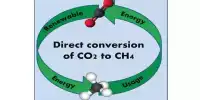According to new research, developing a recycling strategy for a new generation of photovoltaic solar cells made from metal halide perovskites, a family of crystalline materials with structures similar to the natural mineral calcium titanate, will add a stronger dose of environmental friendliness to the green industry.
Tossing out-of-date solar panels into landfills may soon be a thing of the past. According to Cornell-led research published in Nature Sustainability, designing a recycling strategy for a new, upcoming generation of photovoltaic solar cells – made from metal halide perovskites, a family of crystalline materials with structures similar to the natural mineral calcium titanate – will add a stronger dose of environmental friendliness to a green industry.
The paper shows substantial benefits to recycling perovskite solar panels, though they are still in the commercial development stage, said Fengqi You, the Roxanne E. and Michael J. Zak Professor in Energy Systems Engineering in the College of Engineering.
Designing a recycling strategy for a new, forthcoming generation of photovoltaic solar cells – made from metal halide perovskites, a family of crystalline materials with structures like the natural mineral calcium titanate – will add a stronger dose of environmental friendliness to a green industry.
“How do we deal with this kind of an electronic waste when perovskite solar panels reach the end of their useful life?” You, a faculty fellow at the Cornell Atkinson Center for Sustainability, asked. “It’s a new material class.” We could potentially reduce its already low carbon footprint by recycling it properly.
“When scientists design solar cells, they look at performance,” you said. “They seek to understand energy conversion efficiency and stability, but frequently overlook designing for recycling.”
Last year, You and his colleagues discovered that photovoltaic wafers in solar panels with all-perovskite structures outperform photovoltaic cells made of cutting-edge crystalline silicon and that the perovskite-silicon tandem — with cells stacked like pancakes to better absorb light — performs exceptionally well.

Because all-perovskite solar cells consume less energy in the manufacturing process, perovskite photovoltaic wafers provide a faster return on initial energy investment than silicon-based solar panels.
According to the paper, “Life Cycle Assessment of Recycling Strategies for Perovskite Photovoltaic Modules,” co-authored by Xueyu Tian, a doctoral student at Cornell Systems Engineering, and Samuel D. Strauss, recycled perovskite solar cells could result in 72.6 percent lower primary energy consumption and a 71.2 percent reduction in carbon footprint.
“Reducing the amount of energy required to produce the cells indicates a significant reduction in energy payback and greenhouse gas emissions,” Tian explained. The best-recycled perovskite cell architecture could have a one-month energy payback time and a carbon footprint as low as 13.4 grams of carbon dioxide equivalent output per kilowatt-hour of electricity produced. Without recycling, the energy payback time and carbon footprint of new perovskite solar cells range from 70 days to 13 months, and from 27.5 to 158.0 grams of CO2 equivalent over their life cycles.
The energy payback period for today’s market-leading silicon photovoltaic cells is 1.3 to 2.4 years, with an initial carbon footprint of 22.1 to 38.1 grams of carbon dioxide equivalent emissions per kilowatt hour output.
“Recycling allows perovskites to outcompete all other competitors,” Tian explained. Informed state and federal policies, as well as recycling infrastructure development strategies, can further reduce the environmental impacts of photovoltaic solar cell manufacturing. “The true value of an effective green perovskite solar panel industry may rely on a recycling program,” you stated. This study was funded by the National Science Foundation.
















